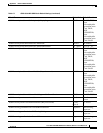
C-30
Cisco ONS 15310-MA SDH Reference Manual, Release 9.1 and Release 9.2
78-19417-01
Appendix C Network Element Defaults
Cisco ONS 15310-MA SDH Node Default Settings
• 1+1 and Optimized 1+1 protection settings—Set whether or not protected circuits have bidirectional
switching, are revertive, and what the reversion time is; set optimized 1+1 detection, recovery, and
verify guard timer values.
• Legal Disclaimer—Set the legal disclaimer that warns users at the login screen about the possible
legal or contractual ramifications of accessing equipment, systems, or networks without
authorization.
• Security Access settings—Set default security settings for LAN access, shell access, serial craft
access, EMS access (including IIOP listener port number), TL1 access, and SNMP access.
• Security Grant Permissions—Set default user security levels for activating/reverting software, PMC
learning, database restoring, and retrieving audit logs.
• Security RADIUS settings—Sets default RADIUS server settings for the accounting port number
and the authentication port number, and whether to enable the node as a final authenticator.
• Security Policy settings—Set the allowable failed logins before lockout, idle user timeout for each
user level, optional lockout duration or manual unlock enabled, password reuse and change
frequency policies, number of characters difference that is required between the old and new
password, password aging by security level, enforced single concurrent session per user, and option
to disable inactive user after a set inactivity period.
• Security Password settings—Set when passwords can be changed, how many characters they must
differ by, whether or not password reuse is allowed, and whether a password change is required on
first login to a new account; set password aging enforcement and user-level specific aging and
warning periods; set how many consecutive identical characters are allowed in a password,
maximum password length, minimum password length, minimum number and combination of
nonalphabetical characters required, and whether or not to allow a password that is a reversal of the
login ID associated with the password.
• BITS Timing settings—Set the AIS threshold, coding, framing, State, and State Out settings for
BITS-1 and BITS-2 timing.
• General Timing settings—Set the mode (External, Line, or Mixed), quality of reserved (RES) timing
(the rule that defines the order of clock quality from lowest to highest), revertive, reversion time,
and synchronization status messaging (SSM) message set for node timing.
Note Any node level defaults changed using the Provisioning > Defaults tab, changes existing node level
provisioning. Although this is service affecting, it depends on the type of defaults changed, for example,
general, and all timing and security attributes. The “Changing default values for some node level
attributes overrides the current provisioning.” message is displayed. The Side Effects column of the
Defaults editor (right-click a column header and select Show Column > Side Effects) explains the effect
of changing the default values. However, when the card level defaults are changed using the
Provisioning > Defaults tab, existing card provisioning remains unaffected.
Note For more information about each individual node setting, refer to the “Change Node Settings” chapter
of the Cisco ONS 15310-MA SDH Procedure Guide.
Note For Cisco ONS 15310-MA SDH CTC level default settings refer to the “C.2 CTC Default Settings”
section on page C-2.


















